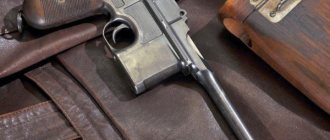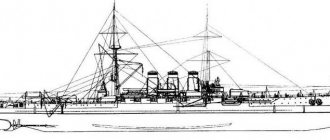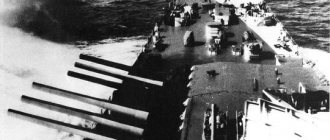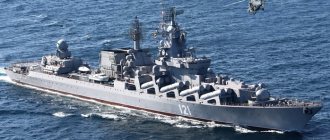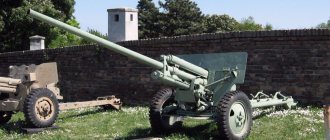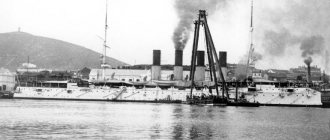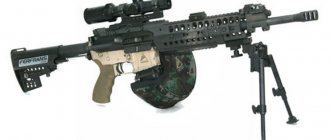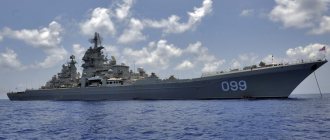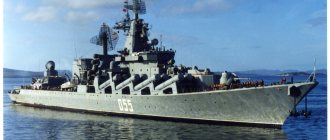History of creation
By the end of the 19th and beginning of the 20th centuries, the Russian Empire was in dire need of a strong fleet in the Pacific Ocean. The eastern borders of the state reached the Sea of Japan. And on the shores of the Yellow Sea, Russia received a lease from China over vast territories of Manchuria, including the ice-free Port Arthur. At the same time, Japan laid claim to these territories, actively developing its navy. To protect its interests and new territories in the region, Russia began to accelerate the construction of ships . Our own shipyards were not enough for this, and many ships were ordered abroad.
The cruiser "Varyag" was laid down in 1898 at the shipyard of the American company William Cramp and Sons in Philadelphia. On October 31, 1899, it was launched , and in 1900, as part of the contract, it was transferred to the Russian Empire. In 1901, the Varyag entered service and was based in Port Arthur.
The ship was built according to a design similar to the designs of cruisers such as Kasagi and Diana. Some developments in the design and construction of the Varyag were taken into account in the development of the high-speed American cruiser St. Louis. According to the documentation, the Varyag was supposed to have a speed of 23.2 knots. But the initially unsuccessful design of the Nikloss boilers, a number of defects during construction, as well as the weak repair base of Russian ports led to the fact that after just a few years of service, the Varyag could not reach a speed of over 14 knots. This fact practically negated the advantages of the cruiser.
Cruiser design
"Varyag" was created as a ship superior in its combat qualities to "Diana" or "Aurora", which were actually already outdated by the beginning of the Russo-Japanese War.
Sketch of two main projections of the cruiser "Varyag"
Indeed, the project of the new cruiser turned out to be quite advanced for the beginning of the 20th century. Unfortunately, at the same time, a number of miscalculations were made during the construction of the ship, which sharply reduced its real combat effectiveness.
Frame
The “backbone” of the cruiser was the keel, which connected the bow and stern stems (massive bars cast from bronze) and consisted of steel profiles and sheets. The so-called floras (transverse sheets forming the frame of the lower part of the ship) were attached directly to it. A second bottom was laid on top of the resulting structure, which extended the entire length of the hull and served as a good support for the power plant and various mechanisms.
The second “roof” of the hull was formed by a massive armored deck, which simultaneously served as the main element of protecting the ship from enemy artillery fire. In the bow of the cruiser there was an elevation (forecastle). Thanks to this, the Varyag could successfully overcome large waves formed during a storm and not lose longitudinal stability. The total height of the hull reached 10.46 meters with a design weight of 2,900 tons.
Armored deck
Protection of the interior of the cruiser was provided by interconnected armor plates with thicknesses of 38.1 and 19 mm, forming a single armored deck, which, because of its configuration, was called “carapace” (that is, turtle-like). It covered the ship not only from above, but also along the sides, dropping 1.1 meters below the waterline. The elevation of the armored deck above the engine room was 7.1 m, and above the main line of the hull - 6.48 m.
The sides of the Varyag were additionally protected by so-called cofferdams - waterproof compartments between the armored deck and the outer skin. Coal pits were adjacent to them on the inside.
Loading coal onto the cruiser "Varyag"
Thus, the damage received when a shell hit the side could be localized without fatal consequences for the ship - even penetration of the armor itself did not lead to damage to vital mechanisms. The rubber dams had no internal contents, although at first they wanted to fill them with cellulose.
Powerplant and propellers
The cruiser "Varyag" was driven by steam engines, the maximum power of which was 20 thousand horsepower, but due to a number of technical reasons this value was never achieved in practice. The operation of the power plant was ensured by thirty Nikloss boilers located in three compartments: 10 in the bow, 12 in the stern and 8 in the middle.
It should be noted that in the last years of the 19th century, Nikloss boilers were a novelty, differing from previously used and similar devices, first of all, in their relatively low weight. The initiator of equipping the Varyag with such boilers was Charles Crump. In the future, this decision turned out to have quite unpleasant consequences, causing numerous breakdowns.
Two three-blade propellers with a pitch of 5.6 meters were used as propulsion devices for the ship. For the initial rotation of the shafts to which they were connected, the cruiser had a kind of “starters” - auxiliary two-cylinder steam engines.
Electrical equipment
A significant part of the mechanisms of the cruiser "Varyag" was equipped with electric drives. In addition, there was a lighting system, a desalination plant and other equipment on board, which also required electricity. The total consumption was more than 400 kilowatts - a lot for a ship of this size at that time.
Nikloss boiler diagram
Energy generation was carried out by three dynamos. One of them was on the living deck, and the other two were on the bow and stern. If they failed, power could be provided according to an emergency circuit, from sixty batteries placed in a special compartment.
The list of main consumers of electricity is as follows:
- Fans (boiler rooms, machine and general ship fans). During operation, up to 119.2 kW was used;
- Lighting. A total of 700 lamps, in nominal mode half of them were turned on, consuming 22.4 kW;
- Gun elevators. Consumed up to 33.3 kW at half load;
- Sump pumps. There were six of them, but usually only one was connected, consuming 40 kW;
- Spotlights. Required 54 kW;
- Winches (boat, garbage and for lifting anchors). Consumed a total of 136.1 kW.
In addition, electricity was used in the galley to operate dough mixers and for other purposes.
Ventilation system
The ventilation on the cruiser "Varyag" was quite powerful and well developed. Particular attention was paid to the engine rooms - the air in them was completely renewed twenty times within an hour. True, when moving at full speed, the temperature inside these rooms still reached forty-three degrees or even more.
In the artillery cellars, an hourly twelve-fold air renewal was provided, and in the remaining internal rooms located under the armor - five-fold. The room allocated for the bow dynamo was the worst ventilated, which is why the temperature inside it often reached 55 degrees.
Life support systems
The cruiser's crew was located mainly on the living deck and partly in the bow, directly under the forecastle.
Cabins
The “lower ranks” were provided with hanging bunks, which were removed during the day, and lockers. The sailors used folding tables for meals.
The best conditions were created for the ship's commander. The premises allocated for it occupied the aft part of the living deck, which extended 12 meters in length. The cabins for officers were single, their area was six square meters. The conductors were accommodated in double cabins. The chief navigator, senior mechanical engineer and senior officer were in slightly better conditions - their cabins had an area of 10 sq.m.
In addition, on the living deck there was an infirmary with a separate operating room, a pharmacy, a bathhouse and a ship's church. There were also two wardrooms - for officers and conductors.
Specifications
Ship type: armored cruiser.
Displacement: normal - 6500 tons, full - 7022 tons.
Length: 129.56 m.
Width: 15.9 m (without lining).
Draft: 5.94 m (midship).
Reservations:
- Armor deck - 38/57/76 mm;
- Conning tower - 152 mm;
- Armor weight - 588 tons.
Engines: vertical triple expansion steam engines, 30 Nikloss steam boilers.
Power: 20000/21000 hp when launching into the water.
Propulsion: 2 three-blade propellers.
Speed: 20.5 knots (after repairs in 1903).
Cruising range (10 knots):
- 6100 miles (with a full supply of coal);
- 3270 miles (with normal coal supply).
Crew: 20 officers, 550 sailors and non-commissioned officers.
Weapons:
Artillery:
- 12 × 152 mm/45;
- 12 × 75 mm/50;
- 8 × 47 mm/43;
- 2 × 37 mm/23;
- 2 × 63 mm/19 Baranovsky guns;
- 2 × 7.62 machine guns.
Mine and torpedo weapons:
- 6 × 381 mm TA (2 in stems, 4 onboard, 12 torpedoes);
- 2 × 254 mm TA (6 throwing mines);
- 35 minutes of barrage.
Last Stand
In January 1904, few people doubted that war would soon begin. In such conditions, the stay of Russian ships far from the main base became increasingly risky, but the Russian ambassador Pavlov did not give permission to return home. Only on January 26, after telegraph communication was interrupted, the “Korean” was sent to Port Arthur. On board this small ship there was a diplomatic post. The Varyag was still anchored in Chemulpo.
Almost immediately after setting out to sea, the Russian gunboat unexpectedly collided with an entire squadron.
The Japanese armored cruiser Asama, the main enemy of the Varyag during the battle at Chemulpo. There are gun turrets at the bow and stern
Near Chemulpo there were:
- Two armored cruisers, including the well-armed and armored Asama;
- Four II class cruisers;
- Four destroyers;
- Three transport ships.
If you believe the commander of the gunboat G.P. Belyaev, the Russian ship was attacked by a torpedo, but survived - the Japanese simply did not hit it. After this, the gunboat had to retreat to Chemulpo. A trial followed - Belyaev reported what had happened to the commander of the “Varyag” V.F. Rudnev, and he turned to the raid senior, the captain of the English cruiser Talbot, for mediation.
The Japanese, justifying their actions, said that the “Korean” threatened their transports. In addition, they denied the fact of launching torpedoes.
Only the next morning Rudnev and Belyaev learned about the start of hostilities. Soon an ultimatum was sent to the Russian cruiser (its author was Uriu, the rear admiral who commanded the enemy naval detachment). The enemy demanded that the Russian ships be withdrawn from Chemulpo, threatening to sink them right in the roadstead if they refused.
On this day, in Chemulpo, in addition to the Varyag, the Korean and the Sungari steamer, there was a gunboat from the US Navy, as well as French, Italian and English cruisers (Pascal, Elba and the already mentioned Talbot). . The commanders of all these ships also received messages from the Japanese with a proposal to leave the port - in order to avoid accidental casualties in a possible battle.
A brief meeting took place on board the Talbot. After discussing the situation, the British, Americans, Italians and French protested to the Japanese admiral. At the same time, V.F. Rudnev appealed to those conferring with a request to escort Russian ships until they left Korean territorial waters, but was refused. It became clear that there would be no serious help from the “neutrals”.
Gunboat "Koreets", the second participant in the battle at Chemulpo
After analyzing the situation, V.F. Rudnev made a fundamental decision to leave Chemulpo (which, in principle, met the requirements of the ultimatum) and break through to his own people, entering battle if necessary. Military councils were held on both Russian ships, all participants of which agreed with the commander’s proposal.
Having made such a decision, the Russian sailors showed the greatest courage, since the Japanese squadron had an overwhelming advantage. The Asama alone could well have destroyed both Russian ships, and the overall superiority of the enemy artillery can be approximately estimated as eightfold.
The anchors were raised at 11:20 a.m., after which the “Varyag” and “Koreets” passed by the anchored foreign ships, greeting the crews of each of them. The orchestra on board alternately performed the national anthems of Great Britain, Italy, France and the USA. It truly was the “last parade”, forever etched in the memory of each of those who were lucky enough to see it.
Foreign sailors quite sincerely admired the courage of people going to certain death, but among the commanders of neutral ships, these feelings were probably also mixed with relief - after all, if the “Varyag” and “Korean” had remained in the bay, the British, Americans, Italians and French would have faced would be an extremely unpleasant choice.
The Japanese rear admiral, who was on board the cruiser Naniwa, did not immediately receive a message about the Russian detachment leaving the port. Nevertheless, he quickly assessed the situation and ordered the commanders of Asama and Chioda to immediately move towards the Varyag. Uriu himself on the Naniva and another ship (Niytaka) followed, with a slight lag.
The cruiser "Naniva" is the flagship of the squadron of Rear Admiral Uriu
The enemy was noticed by Russian officers in a timely manner, although they did not quite correctly perceive the meaning of the Japanese maneuver. Rudnev believed that the Japanese were lining up in a wake column, which in reality did not happen. After reaching a distance of 45 cables, signals appeared on the masts of the Japanese flagship - Uriu proposed surrender. There was no answer.
At 11:44 am the first shots were fired. They were made by Asama artillerymen, firing several high-explosive shells. They went over the top, exploding upon impact with water, which surprised Rudnev at first.
At 11.47, the Varyag's six-inch guns began shooting. Apparently, it was at this moment or a little earlier that the first enemy shell hit the Russian cruiser. As a result, one of the rangefinder teams was almost completely destroyed. The midshipman who led it died instantly (only a fragment of his hand remained). The same fate befell two of his subordinates, and three more sailors were seriously injured. These first losses deprived the Varyag of the ability to provide adequate accuracy of artillery fire.
Almost immediately after this, the Japanese managed to disable the entire crew of the six-inch gun No. 3. The Russian artillerymen were hit by shell fragments, which did not even hit the ship itself, but exploded not far from the side. The American designers should be thanked for this - after all, it was they who, during the construction of the cruiser, insisted on installing unprotected guns on the upper deck.
The "Korean" opened fire on the Japanese ships at the same time as the "Varyag", but it immediately became clear that the gunboat would not be able to help its comrades - its outdated guns, designed to use black powder, did not have the necessary range.
The cruiser "Varyag" after returning from battle
Meanwhile, two more enemy cruisers began firing at the Russian detachment. From time to time, individual shells also arrived, fired by Japanese ships that were still at a greater distance.
The Varyag artillerymen responded to the enemy, firing rather intensively, but no results were noticed. According to one of the British officers who observed the battle, at some point the flagship of the Japanese squadron found itself in a dangerous position, but this ship quickly left the first line, dodging fire.
The fire that broke out on the Varyag after another hit (presumably a six-inch shell) was extinguished, but the number of wounded was constantly increasing. In addition, the 75-mm guns began to fail, not from Japanese fire, but due to some design defects - the knurling guns could not withstand intense fire.
At 12:15 a.m., at the moment when the Russian cruiser was making the turn required by the route, the drives of its rudders were smashed by a shell that hit the side not far from the conning tower. The next hit led to the death of the entire crew of one of the guns and the wounding of the ship's commander. He himself, however, by the will of fate, suffered only slightly, while the sailors next to him died.
Due to a temporary loss of control, the Varyag ran aground and immediately received several more shells on the left side. The only thing that saved the Russian cruiser from death at that moment was that the enemy did not immediately appreciate the full danger of the Varyag’s position. Nevertheless, the damage suffered was so great that it became impossible to continue the battle - due to underwater holes, the ship tilted dangerously. At the same time, the influx of sea water apparently caused the Varyag to slide off the shoal stern first.
The cruiser "Varyag" after sinking in the inner roadstead of Chemulpo
The Russian ships began to retreat back to the inner roadstead. The Varyag team managed to accelerate the heavily damaged cruiser to 11 knots, despite the fire that broke out on the living deck. Further damage was avoided, since the pursuit was carried out by only one armored cruiser - the remaining ships were not squeezed into the narrow channel. According to some reports, a destroyer tried to attack before entering the inner roadstead, but the Japanese deny this information.
The battle ended at 12.45 - exactly an hour after the first shots were fired. The sight of a tilted cruiser, on the deck of which lay corpses and separate pieces of bodies, spoke quite eloquently about the results of the battle. Unfortunately, despite all the efforts of the Varyag crew, the enemy did not suffer any damage. According to a report from Japanese Rear Admiral Uriu, none of the shells fired by Russian guns reached their targets.
Meanwhile, Rudnev’s report stated that the Asama was seriously damaged in the battle, one of the enemy’s destroyers was killed under fire, and the Takachiho was damaged so badly that this subsequently led to its sinking. The commander of the Varyag insisted on this version of events even several years later, despite the fact that the “drowned” cruiser Takachiho sailed safely on the seas for more than ten years after this battle.
In addition, Rudnev stated that during the battle, Russian artillerymen spent 1,105 shells, achieving a record rate of fire. Subsequent verification showed that this statement is extremely far from reality. What Rudnev was counting on by so clearly distorting the truth is impossible to understand today. One way or another, with his fantasies he largely blurred the impression of his own feat and the heroism of other participants in the battle.
The rise of the "Varyag" from the bottom, summer 1905
The further fate of the ship
Having counted the losses (they amounted to 39 people killed and 74 wounded) and assessed the damage received during the battle, the Varyag officers decided to sink their ship so that it would not fall to the enemy. It should be noted that the gunboat “Koreets” was practically not damaged during the battle, but it would not have been able to fight alone under any circumstances. Therefore, it was decided to destroy it too.
Subsequently, Rudnev was repeatedly reproached for not blowing up the Varyag, but only scuttling it, and even in a shallow place. However, this decision was forced - the Talbot was located near the Russian cruiser, which could have been damaged by the explosion. Meanwhile, there was little time left for any other actions - the Japanese could enter the port at any time.
After the evacuation of the team, at 15:50 on January 27 (February 8), 1904, Rudnev personally opened the seams of the cruiser Varyag. The ship began to slowly sink to the bottom of the bay. At 16.05 the “Korean” was blown up, the wreckage of which immediately disappeared under water. In addition, the Russian transport Sungari also had to be sunk.
At 18:10 the Varyag completely sank. It seemed that the ship’s story would end there, but it turned out differently. In August 1905, the cruiser was raised from the water by the Japanese. Two weeks later, she was incorporated into the Imperial Japanese Navy under the name Soya.
The cruiser "Varyag", which landed on rocks off the coast of Scotland. The photo was taken in 1920
The captured cruiser was used mainly for training sailors. Of course, for this he needed repairs, which lasted until July 1907. By this time, relations between Japan and Russia had improved significantly. One of the results of the “thaw” was the awarding of Rudnev with the second most important Japanese order. Moreover, the death of the Varyag was considered in Japan an example of service to the Motherland, and a brief summary of the battle at Chemulpo was necessarily told to everyone who served on the Soya.
In 1916, the Russian government managed to buy the Varyag and return it to its homeland. The ship was transferred from the Pacific Fleet to the Arctic Ocean flotilla. The famous cruiser did not take part in the battles, and at the beginning of 1917 she was sent to Great Britain for further repairs.
On November 7, 1917, a revolution took place in Russia, as a result of which the Bolshevik government came to power. Since the Council of People's Commissars refused to pay the debts of the Russian Empire, the British decided to confiscate the Varyag. The ship remained at anchor until 1920, after which it was sold to Germany for cutting up for metal. For some reason, sending it to the disposal site was delayed, and only in 1925 they tried to tow the cruiser to the German shores. The Varyag did not reach its destination - it was destroyed by a strong storm. This happened in the Irish Sea. They no longer began to raise the remains of the ship - instead, they were detonated.
For some time in the USSR they did not remember the heroes of “Varyag”, but in the post-war years this situation changed. The Project 58 guards missile cruiser, launched in 1963, was named in honor of the legendary ship. Subsequently, the Varyag GRKr made many cruises, serving until 1990.
Modern guards missile cruiser "Varyag"
The next bearer of the illustrious name was to be an aircraft carrier built in the city of Nikolaev (project 1143.6). But due to the collapse of the USSR, the construction of this ship was not completed, and later China bought it. Nevertheless, the Varyag soon reappeared in the Russian Navy - this name was assigned to the modern Guards Missile Cruiser (GVRK), originally called Chervona Ukraine. This ship remains in service today.

